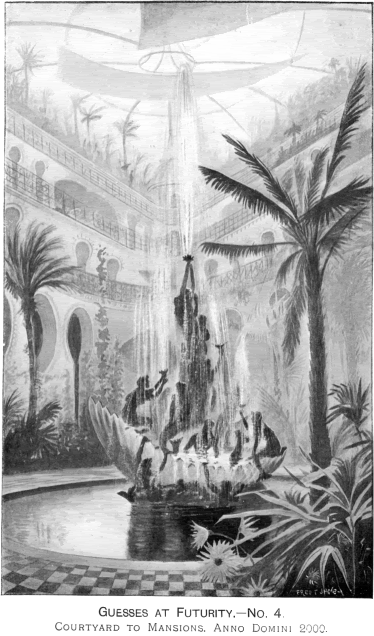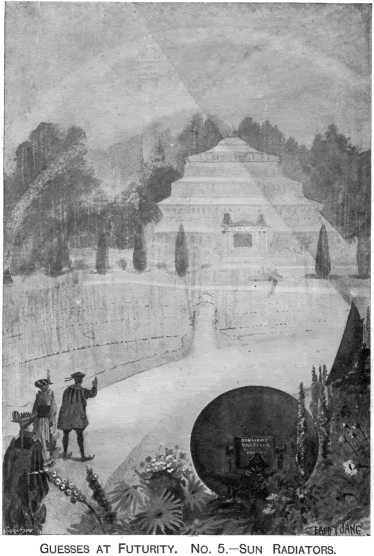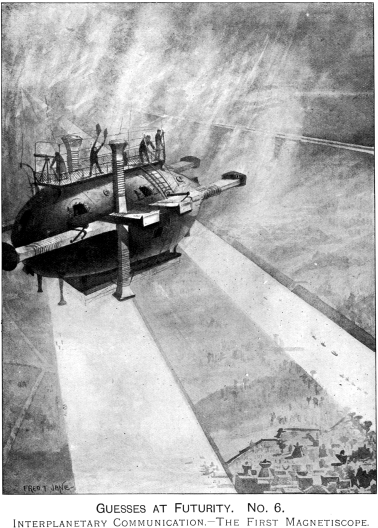
The Visionaries, Madmen, and Tinkerers Who Created the Future That Never Was
MENU OF CHEMICAL FOODS

Fred T. Jane, like an amazing number of other Victorians, had a multitude of careers. He’s best known today for editing the definitive series of works on the capabilities of military craft, which he started with All the World’s Fighting Ships in 1898, adding All the World’s Air-Ships in 1909. He wrote almost a dozen novels as well, including many that qualify as science fiction. His greatest gift to all later writers was the matter transmitter. In his telling it was invented by the ancient Egyptians and used by them to travel to Central America, explaining the similarities between pyramids. Some flaw - a fairly large one, actually - in the system found them winding up on Venus instead, perhaps because the native race there, described as combining “aspects of a small elephant and large horse-fly,” also had matter transmitters. A colony developed, with lovely red-skinned women, one of whom visits earth in the aptly titled satiric 1897 novel To Venus in Five Seconds. From then on, heroes could bounce from planet to planet without the tedium of space travel.
Jane started as an illustrator, producing the illustrations not only for his own novels but also for the stories of George Griffith, probably the leading British writer of scientific romances before H. G. Wells. And in those ridiculously busy 1890s he found the time to contribute a series of stiff but lavish full-page drawings called “Guesses at Futurity.” Jane must have had a fixation with Egypt, because "Guesses at Futurity. No. 8. A Dinner Party A.D. 2000. Menu of Chemical Foods." (The Pall Mall Magazine, May 1895, p 96.) seems to be set in an Egyptian temple, with the waiters dressed as extras from a Cecil B. DeMille epic. They are carrying trays of pellets, presumably the chemical foods of the title, to robed men in large armchairs. Above the seated figures’ heads are helmets that make them look like they’re about to get their perms set, although they may be thought transmitters or vanquishing head lice for all the explanation we receive. Something can be seen in the air through the huge glass skylight, but those might be balloons, rockets, or the discarded wine goblets blasting into space. I enhanced the image somewhat to try to bring out the detail in a poor copy. Make your own guesses.
Please note that Marcus L. Rowland, who runs the Forgotten Futures role-playing game, says on his Meme-Free Zone blog that the Menu of Chemical Foods is by Francis Masey, not Jane. He doesn't give a reason for this, but it's true that this picture is unsigned and Jane normally signed his art. I don't see a signature on Glimpses No. 3, though, and the Index to Vol. VI, May to August 1895 for that Pall Mall Magazine volume shown on Google Books assigns it to F. T. Jane. Image No. 9, however, is specifically indexed under Francis Masey.
All the other eight images are shown in the gallery below. [Click on any to enlarge.] No. 9 is clearly by another hand, someone with less of a pseudoclassical style fetish, indeed a notion of a future that wouldn't be out of line today as shown by the buses on the double-decked streets. It is, in fact, signed by Masey and one wishes that he did more in the series. His is a deft touch.
Jane's vision is of a more leisurely and genteel future than most American artists of the day portrayed, clearly aimed at the upper class audience expected to read a magazine named after a London street housing a number of the upper-crust gentlemen's clubs that the chemical-eaters were descendants of. (Compare Jane to the rip-off series "Glimpses of the Future," run in Life, an American humor magazine in 1897.) Jane anticipated DeMille not just in design but in the giganticness of his sets. The Housetop Garden in No. 2 is only slightly smaller than the Hanging Gardens of Babylon, probably necessary to keep in scale with the drawing room pictured in No. 1, which is the size of an opera house and decked out as a home theater. The inhabitants sit in their wide seats watching a screen bigger than any modern plasma set, while the latest news scrolls on papyri taller than any of the men. The Courtyard to the Mansion in No. 4 seems to be pulled from a Las Vegas hotel, judging by the size of the fountain. The Sun Radiators in No. 5 are labeled "sunlight collectors" and may be illuminating the temple in the background to facilitate night-time tourism. Is that Marco Polo there on the left? No. 6 and No. 7 are both labeled Interplanetary Communication, although the man who appears to be using signal flags on top of the flying boiler, pardon me, the Magnetiscope, couldn't be seen by anyone even on the ground. Gold Mining in the Mountains of the Moon, the subtitle of No. 7, is not normally what's considered either interplanetary or communication, although the idea that the Moon was stuffed with gold and thereby would be worth the expense of getting there appears in a number of late 19th century stories. Given these examples, Leibniz's line about the present being big with the future was seldom taken more literally.
∞

Pall Mall Magazine, October 1894

Pall Mall Magazine, November 1894

Pall Mall Magazine, December 1894

Pall Mall Magazine, January 1895

Pall Mall Magazine, February 1895

Pall Mall Magazine, March 1895

Pall Mall Magazine, March 1895

Pall Mall Magazine, June 1895